Welcome to the third and final part in our series on processing big game at home. In case you missed it, in Part 1 we covered the necessary supplies and how to get started. In Part 2 we covered how to break down a big game hindquarter.
In this third and final part in the series, we’ll offer some ideas for how to use the front shoulders of a big game animal, how to care for the backstraps and tenderloins, plus what to do with the neck meat and other odds and ends. We also have some ideas for improving your ground meat. Have your own processing tips? Please share by leaving them in the comments below!
MAINTAINING QUALITY THROUGHOUT THE PROCESS
In the previous two parts in this series, we’ve touched on the importance of good meat care practices in the field and when transporting it home. We can’t possibly overstate how important this is. If you want to end up with great tasting wild game meat, it must begin immediately upon harvest.
If something tastes bad, don’t blame the deer! While the age of an animal and other factors can make the meat tough, gamey-tasting meat is almost always the result of preventable mistakes in the field. Check out this previous article on how to care for meat in warm weather. Or this one with some more field care tips.
Here are the main points to remember: cool it down quickly by immediately removing the hide to allow airflow. Keep it clean and promote continued air circulation by using high quality, breathable game bags. Hang it in a cool, shady area overnight, then get it into a cooler if necessary to lower the core temperature. And finally, keep it dry. Suspend a Hunter’s Tarp over the meat when it’s hanging outside. If it’s in a cooler, use frozen water jugs to keep water contained. When using bagged ice, place the meat above the ice with a barrier like the Hunter’s Tarp to prevent the meat from getting soaked.

In short, give it airflow, keep it cool and keep it dry. Do that, and your end product at home will be much more enjoyable.
WHAT TO DO WITH THE FRONT SHOULDERS
The front shoulders of a big game animal are pretty easy and quick to take care of. Compared to the hindquarter with its many different muscles and cuts of meat, the front quarters are relatively simple.
Cleaning Up Bloodshot Meat
Honestly, the hardest part of processing a front quarter can be removing any bloodshot areas. It’s common for the front shoulders to sustain some damage from the hydrostatic shock of a bullet. But while this might look like a mess at first, it’s actually very easy. Don’t let first appearances deter you. Once you begin cutting away these bloodshot areas, it cleans up quite fast.
As you begin, it helps to have a garbage can beside you lined with a heavy-duty trash bag. Start by cutting away any gelatinous chunks that are obviously bloodshot and toss them in the trash. As you remove the worst of it, you’ll gain better visibility into the surrounding meat. Continue cutting away any purple-ish bloodshot parts until you’re left with the good-looking meat.
Once the front shoulder is cleaned of any bloodshot parts, give it a good cleaning with a vinegar-water solution. We covered this in more detail in Part 1. But in summary, this removes any stray hairs, dirt and other contaminants before you place it on a clean cutting board for butchering. It also rehydrates the outer layer of meat. Even if your meat has been hanging for days, this outer “rind” that forms is very usable meat. Simply trim it away and add it to your ground meat.
What To Do With a Big Game Shoulder
Once it’s clean and ready on your cutting board, there are a few possibilities of how you can process and prepare your big game shoulders. Start with a high quality knife, we prefer this combo set from Knives of Alaska. Many big game hunters set aside their shoulders for grinding into sausage and burger. If your family goes through a lot of burger and sausage like mine, this is a great use for the shoulders, especially from a big animal like an elk.
However, that’s not the only option. From smaller animals like an antelope, I like to save whole, bone-in shoulder roasts. These make great pot roasts, barbeque, or shredded taco meat, barbacoa style. On a small animal, you could simply remove the shank (that’s the drumstick looking piece below the knee) and save the entire shoulder whole. This can make a fun meal for a big family gathering. In most situations however, I’ll cut my bone-in shoulder roasts into 2lb. or 3lb family-sized pieces. Use a hacksaw or sawzall to quickly cut through the thin shoulderblade of a small animal to cut it into appropriate portions for your family.

If you like saving as many steaks as possible from your big game animals, then be sure and save the flatiron from the front shoulder. You’ll find the flatiron tucked under the chuck or blade roast, which is on the upper/outside part of the shoulder. The flatiron is excellent when grilled to medium-rare and then sliced against the grain.
What To Do With The Shanks
We mentioned the shanks in Part 2 of this series when breaking down a hindquarter. The front shanks can be treated exactly the same as the rear shanks. You can remove the shank from the front shoulder by working your knife through the joint that holds them together. Or to make quick work of it, feel free to use a hacksaw or sawzall.
You can debone the shank meat and add it to your burger or sausage. My preference however, is to save the shanks whole. They are perfect for braising, as all that connective tissue and collagen breaks down and creates great flavor and texture. All it needs is liquid, heat and time. Look up any braised shank recipe and give it a try.
Tips for Grinding Wild Game
For some ideas on choosing a grinder, see Part 1 in this series, as we discussed equipment for getting started. Since front quarters will often end up as burger or sausage, here are a few tips before you send it through the grinder…
Start by putting your meat grinder parts into the freezer for at least an hour before you begin. This includes the tray, the auger, the blade and the grinding plates – pretty much everything except the motor itself. This will help keep the meat cold as it passes through the grinder – an essential part of quality ground meat.
Before you begin, decide if you want to add fat to your ground meat. Most of the time, I’ll add between 10% and 15% fat to my burger. I prefer pork fatback because it has a milder flavor than beef fat, which allows the venison to shine. But either one works perfectly fine. If you plan to make sausage, carefully follow a sausage recipe. Most sausage recipes call for a much higher percentage of fat.

4.5mm Grinding Plate
Cube the meat and fat into pieces that will fit into your grinder and mix them up in a large meat lug (again, see Part 1 for suggested supplies). Before grinding them, put these cubed pieces into the freezer for 30 minutes or an hour. You want them partially frozen – not solid, but just firm. This will greatly improve the texture of your ground meat. Fully thawed meat has a tendency to be mushy when it runs through a grinder. Partially frozen meat will give you that perfect, pelletized texture. It will also improve your grinder’s ability to handle silverskin and connective tissues.
In most cases, I’ll double-grind my burger, first running it through using a 7mm plate and then again using a 4.5mm plate. This gives the meat a nice versatile texture for any ground meat recipe. Just remember that cold meat is essential. Between the first and second grind, clean your grinder parts and place them in the freezer along with the single-ground meat. Make sure everything is extremely cold before going ahead with the second grind.
BACKSTRAPS AND TENDERLOINS
We don’t need to spend too much time on the backstraps (also known as loins) and the tenderloins (inside loins), because really they speak for themselves. These are among the best pieces of meat from any big game animal. A little salt and pepper and a hot grill to medium rare is really all they need. But insofar as it’s helpful, here are a few ideas…
When it comes to cleaning these up after a hunt, follow the clean cutting tip that we mentioned in Part 1 of this series, using a vinegar-water solution and then patting it dry. This helps clean up the outside of the meat, removing any hair or other debris.

Elk Loin Before Fat and Silverskin Has Been Removed
From there, remove any fat from the outside of the loins. Venison fat can go bad even in the freezer and in most cases, it’s not pleasant to eat anyway. Next, when working on the backstrap, remove the long piece of meat that’s connected to the side of the loin. This can be added to your ground meat. What you do with the loins from here is entirely up to you. Some folks like to cut them into steaks. Personally, I prefer to save them in 2-3lb. roasts (usually thirds on a big mule deer or cow elk). These whole loin roasts are excellent when grilled or roasted and then sliced.
Before cooking, you’ll need to remove the silverskin from the outside of the backstrap. However, if I’m planning to freeze them anyway, I’ll leave the silverskin on. It adds an extra layer of protection in the freezer. Then I’ll remove that silverskin later when I thaw it out for cooking.

Backstrap Roasts: Leave Silverskin When Freezing (top). Remove Silverskin Before Cooking (bottom).
NECK MEAT AND OTHER PARTS
The neck meat is usually a top candidate for the grinder. From a big animal like an elk, the neck represents a sizeable piece of meat. If you use a lot of burger or sausage at your house, grind away! However, I do like saving at least one neck roast each season. This is an excellent piece for your favorite pot roast or slow-cooker meals. Just like the shanks, all that connective tissue breaks down when cooked low and slow in a braising liquid, creating excellent flavor and texture.

Neck Roast from a Cow Elk
Most everything else from your big game harvests, including brisket, rib meat and other trim will most often be added to burger or sausage. Ribs can be cooked on the bone when tenderized first in a pressure cooker. But for most folks, these tough pieces are easy additions to the grind pile.

Elk Heart
Finally, two of my favorite pieces from any big game animal are the heart and the tongue. If you’ve never taken the time to save these, give it a try next time. Especially the heart! The heart is an easy thing to like. It’s definitely more of a muscle than an organ, and very steak-like. When cleaned up, marinated and given a hot sear to medium-rare, it’s excellent. I can understand the aversion to tongue – it looks weird. But if you can get over the appearance, it’s very good. Look up a tongue taco recipe and give it a shot!

Elk Tongue
CONTACT US WITH QUESTIONS
We hope you found this series on big game processing helpful. If you have your own tips or ideas, don’t forget to leave them in the comments! If you have questions – whether it’s about meat care or getting the right gear for your next big game hunt – please don’t hesitate to ask. We offer free shipping on orders over $49 and we’d love to help you get ready for your next adventure!

By Ryan McSparran








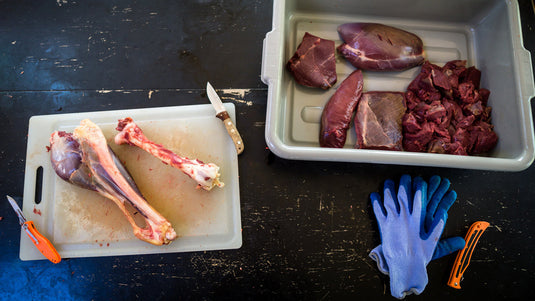
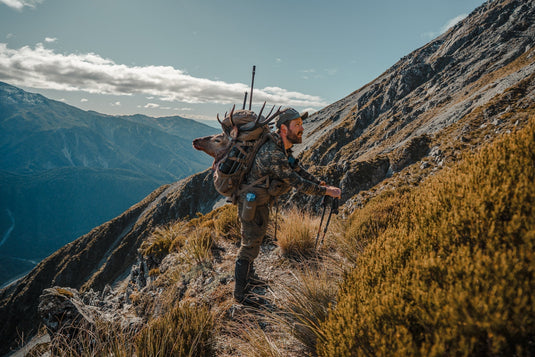
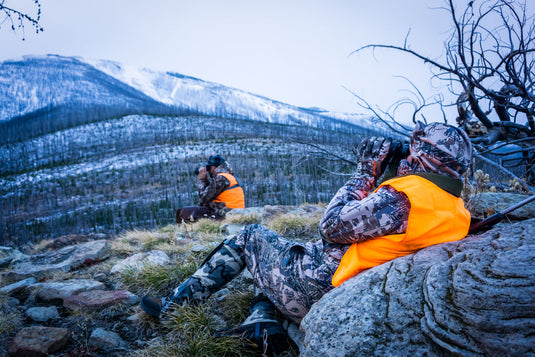
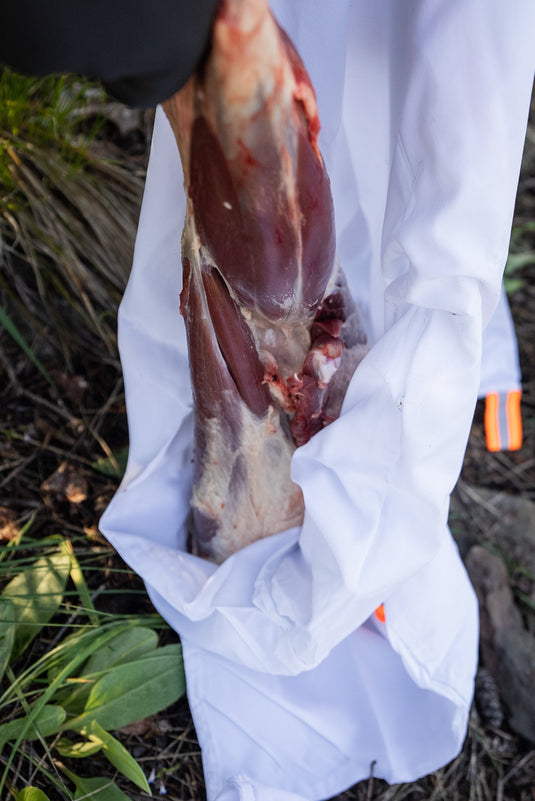
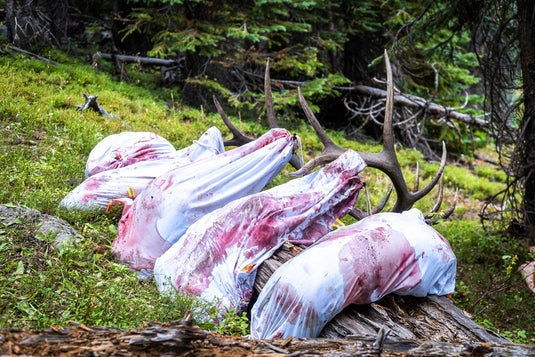
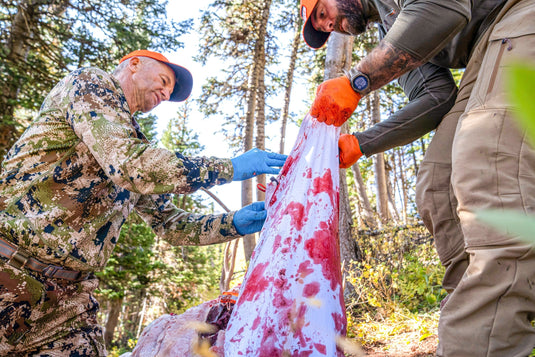
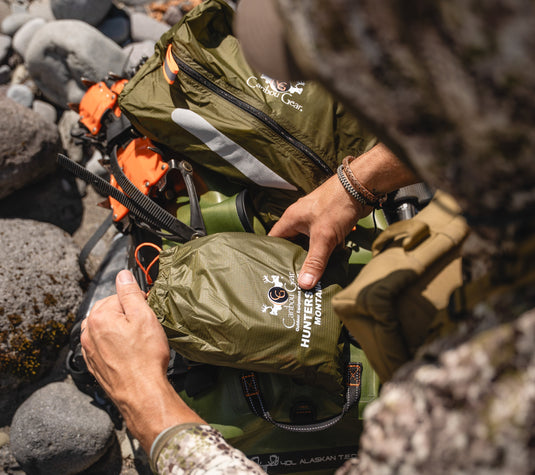
For everyone that can’t get their head around eating tongue, if you’d still like to get quality use, the tongue actually is the absolute best hair remover! After you remove it, just wipe the meat up and down and you’ll be amazed at how simple it is to remove all the unwanted hair!
I like the liver fresh or frozen. I cook it in bacon grease with onions. I cook heart the same way. I give tongue to a friend whose wife boils it for eight hours before pealing off the outer layer then serving as an appetizer with salsa and chips. Our guide’s wife in British Columbia prepared it for sandwiches which I enjoyed even a couple of days later. I don’t know how she prepared it.
Excellent articles on Meat Care and Home Butchering. For years I have been doing my own meat cutting and trying to get my partners to do it as well. Hopefully these articles will convince them it is not as hard as it might seem. Where we live in Washington State, it is getting harder and harder to find a wild game butcher. The ones still in business have full lockers after opening weekend. One of my buddies had to call 4 butchers before he found one who would take his deer. I did my own and didn’t have to wait 4 weeks to get my meat back. If you don’t want to do the ground meat thing at home, save all your ground meat, freeze it, then take it to the butcher. They always have space and you get it back in nice little white packages with no big mess on your hands.